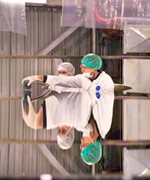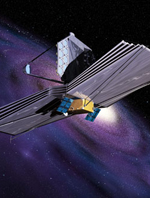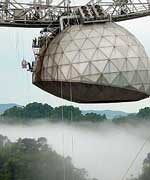Today, the world of astronomy meets the science fiction world of Isaac Asimov’s “I, Robot” with the commissioning of a new robotic telescope. While it lacks the humanoid qualities of the movie version, this robot will aid in humanity’s quest to understand the early universe by observing the most distant and powerful explosions known.
Located at the Fred L. Whipple Observatory on Mt. Hopkins, Arizona, the Peters Automated Infrared Imaging Telescope (PAIRITEL) is the first fully “robotic” infrared telescope in North America dedicated to observing transient astronomical events. The telescope, used for several years in a major all-sky survey (2MASS), has been refurbished to work autonomously. It will operate in tandem with NASA’s new gamma-ray burst satellite “Swift,” to be launched on November 8 from Kennedy Space Center.
With PAIRITEL, a team of astronomers led by Dr. Joshua Bloom of the Harvard Society of Fellows, Harvard-Smithsonian Center for Astrophysics (CfA) and UC Berkeley, hopes to pinpoint the gamma-ray burst explosions from the first and most distant stars in the universe. A gamma ray burst (GRB) is a quick flash of gamma-ray radiation lasting about a minute, accompanied by an afterglow emission of X-rays, visible, infrared, and radio light. The afterglow may be observable for days to weeks afterward. The majority of GRBs are believed to be due to massive stars that explode violently and release tremendous blasts of energy.
“Innovatively exploring the night sky in the time domain – seeing how things change from night to night, and even from minute to minute – is the next big frontier in astronomy,” said Bloom. “PAIRITEL was optimized to study cosmic events like GRBs that are here today and gone tomorrow.”
Peering back to a time when the universe was less than 1 billion years old is the holy grail of observational astronomy. So far, only energetic galaxy cores known as quasars have been used to probe the early universe. But gamma-ray burst afterglows, if astronomers are able to image them quickly, hold clear advantages over quasars. For up to one hour after the burst, afterglow brightnesses can reach up to 1000 times that of the brightest known quasar in the universe.
Also, explained Bloom, “The stars that create GRBs likely formed before the black holes that create quasars. So by looking for the youngest and most distant GRBs, we can study the earliest epochs of the universe.”
A key feature of PAIRITEL that will allow the location of distant GRBs is its rapid response time. PAIRITEL will receive signals from Swift and automatically move, in under 2 minutes, to the part of the sky where a GRB has appeared.
“My ultimate vision is to have astronomy robots talking to robots, deciding what to observe and how, with no human intervention,” said Bloom. “As it is, PAIRITEL only e-mails us when it’s found a particularly interesting source, or when something goes wrong and it needs help!”
Another key feature of PAIRITEL is its sensitivity at infrared wavelengths, setting this system apart from the bevy of visible-light robotic telescopes already in existence. Images taken with infrared filters (about twice the wavelength of visible light) are indispensable: visible light emitted from more than 12 billion light-years away is completely extinguished for observers on Earth. Bloom explained, “Forget about the dimming due to the extreme distances: the hydrogen gas between us and the explosions makes it like searching for a firefly behind a thick London fog. In the infrared we can peer through the shroud to the good stuff.” In addition, the unique camera on PAIRITEL takes pictures simultaneously at three different wavelengths of light, allowing for instantaneous full-color snapshots.
The Swift spacecraft will find GRBs at a rate 10 to 20 times higher than currently feasible, and should find more bursts in 6 months than all well-studied bursts to date. Bloom said he is most excited about using Swift and PAIRITEL “together to find the golden needle in the haystack – a high-redshift GRB that’s farther away than the most distant known galaxy or quasar.”
When PAIRITEL is not chasing down GRBs, it will be used to make precision measurements of supernovae to help determine the few fundamental parameters that dictate the expansion of the universe. Among other projects, Dr. Michael Pahre (CfA) will use PAIRITEL to study the near-infrared light of nearby galaxies to compare it with mid-infrared light in images obtained with NASA’s Spitzer Space Telescope. Harvard graduate student Cullen Blake, who has written software for the project, will also use PAIRITEL to try to find Earth-mass planets around brown dwarfs. Other PAIRITEL team members include: Prof. Mike Skrutskie (Univ. of Virginia), Dr. Andrew Szentgyorgyi (CfA), Prof. Robert Kirshner (Harvard University/CfA), Dr. Emilio Falco (CfA), Dr. Thomas Matheson (NOAO), and Dan Starr (Gemini Observatory, Hawaii). The staff of Mt. Hopkins-Wayne Peters, Bob Hutchins, and Ted Groner-worked on the automation of the telescope.
PAIRITEL, nearly 2 years after the inception of the project, is being dedicated today to the late Jim Peters, who worked for the Smithsonian Astrophysical Observatory, first on satellite tracking and then as a telescope operator on Mt. Hopkins for 25 years. His widow and son will be in attendance at the ceremony.
The project was funded by a grant from the Harvard Milton Fund. The telescope is owned by the Smithsonian Astrophysical Observatory and the infrared camera is on loan from the University of Virginia.
Additional information about Swift and PAIRITEL is available online at:
http://swift.gsfc.nasa.gov/docs/swift/swiftsc.html
http://pairitel.org/
Original Source: CfA News Release



